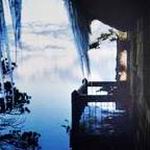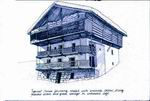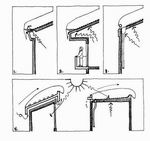In contrast to
ANSI, the 1982 Uniform Building Code permits snow loads to be set at
the discretion of thebuilding official and permits a reduction in loading
ir excess of 20 pounds per square foot for each degree of slope in excess
of 20 degrees, regardless of the roof design or material. This practice
is unsafe, especially in the mountains or heavily snowed areas.
Ice dams (Figure 3), are the most common and unpleasant difficulty bedeviling
pitched roofs. They can prevent the shedding of snow from even very
steep roofs. Radiant heat from the sun or convection heat from the building
interior melts the snow on the roof. The moisture generated collects
at the outer face of the roof and is prevented from refreezing by the
insulation of the snow blanket. It drains to the edge of the roof and,
if the air temperature is below freezing, it turns to ice where it exits
from under the snow.
If the snow blanket on the roof is thick, the temperature at the roof
face will normally be below freezing (32 degrees Fahrenheit) even though
the air temperature may be much colder. After several days, a sizable
pool of water will build up under the snow blanket behind an ice dam
at the eaves. On a 40-foot-long, R20 sloping roof covered with three
feet of snow, roughly two gallons of water will be deposited at every
lineal foot of eave every day if the interior is 70 degrees.
On a roof pitched 4 in 12(15 degrees), an ice dam three feet thick
will back water more than nine feet up the roof. This produces hydrostatic
pressure that will cause a conventional shingle roof to leak.
None of the building codes used in the U.S. today considers this problem,
and yet it is the most frequent defect of sloping roofs in cold country.
As the snow and ice slide from a sloping roof, as they will when weather
conditions change, great danger can occur. An ice dam may hold snow,
ice, and water attached to the roof through several storms until a great
mass is accumulated. When it at last falls, it can crush anything in
the way.
The ice dam and its family of icicles may break off (Figure 4), bounce
off snow banks built up by previous slippage from the roof, and crush
the lower walls of the building. This is a much more frequent cause
of building collapse than roof failure in the deep snow country.
With sloping roofs in snow country, it is impossible to eliminate ice
damming problems, but there are several methods for controlling them,
including the cold roof, increased insulation, heat leaks at the roof
edge, heated eaves, and, if all else fails, electric heat tape. (Figures
5, 6)
The cold roof is actually two roofs with an air space in between for
the flow of outside air. The outer roof acts as an umbrella and holds
the frozen snow, while the insulated inner roof keeps the heat within
the building. The air space pre- vents building heat from melting the
snow on the outer roof. However, the air space does not prevent melting
from sun radiation or warm air. Snow is a good absorber of long wave
length radiation (infrared), so although snow reflects visible light,
it will absorb considerable energy from sunshine, especially at higher
elevations. If ambient air temperature rises above freezing for any
length of time during the day, this will cause the snow on the upper
roof to melt from below.
At a significantly higher construction cost, and at the loss of being
able to utilize the natural insulative properties of the snow, the cold
roof does tend to retard ice damming. But the cold roof only works well
on shady sites where winter air temperatures rarely rise above freezing.
In climates where the air temperature goes above freezing in the day
and falls below at night, the cycle of freeze/thaw will construct ice
dams on a cold roof as large as those on a warm roof.
There is also a drawback to a cold roof in very cold climates. Fine
wind-blown snow can collect between the inner and outer roofs, preventing
free air circulation and causing leakage and ice damming. The wind-blown
snow, which can be subjected to the freeze-thaw cycle because of the
interior building heat, may even force the upper and lower roof layers
apart.
|





